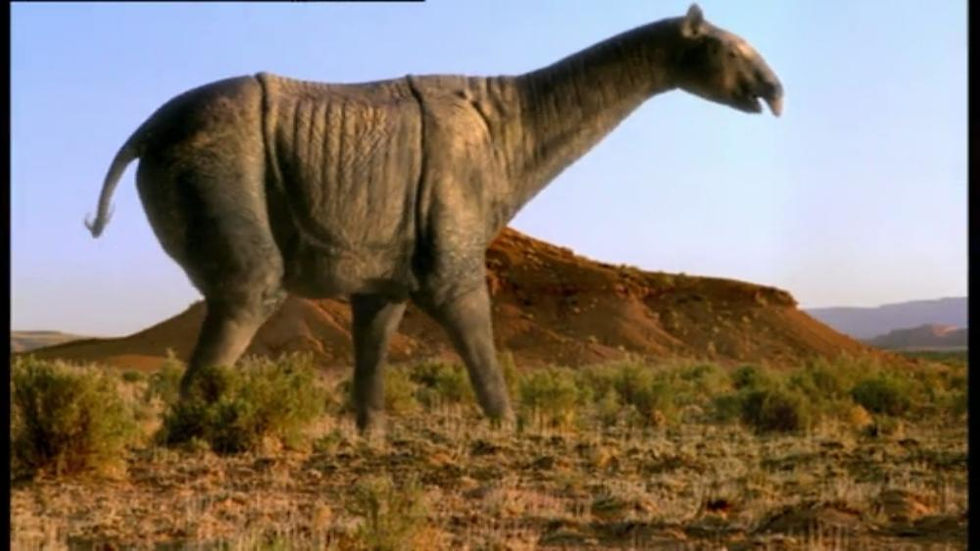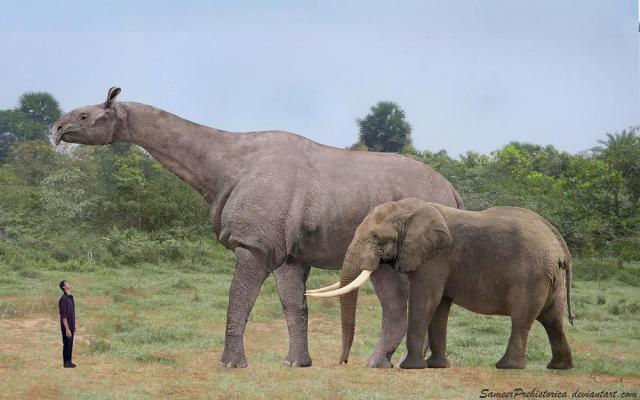
CREATURE-PEDIA
Indricotherium




Fun Fact
Indricotherium was a large relative of a rhino.
Indricotherium (also known as Paraceratherium) was a genus of perissodactyl mammal which lived during the Oligocene period. Indricotherium was one of the largest land mammal in the world, it was so big that a 6 foot man could easily fit between its legs. It stood 25 feet tall, it was nearly twice as tall and 3x heavy (up to 22 tons) than the African elephant and at 26 feet from nose to tail. Indricotherium were distantly related to modern rhinos, and their closest relatives were primitive perissodactyl mammals like Hyracotherium, but their size put them into a different league from other plant eating mammals. A fully grown male Indricotherium stood over 7 to 8 meters tall and weighed in at 20 tons, while females can weigh up to 15 tons (which is equivalent to 8 modern rhinos) and newborn calves can weigh around 250 kg. They were among the biggest animals of their time since the Mesozoic sauropod dinosaurs. They were also among the largest mammalian land animal of all time. Despite their appearance, they weren't related to giraffes but to rhinoceroses. When it came to mating, males often get into fights and their skulls were specially built to withstand these contests. But when the fights were over, calves were at serious risk–the biggest threat to an Indricotherium calf was an adult male. During mating, calves could be trampled to death. Whenever the females gave birth to newborns, they were faced with danger with predators, like Hyaenodon, trying to get to their babies, the mothers desperately tried to keep their babies between their legs so they could defend them with powerful kicks. When indricotherium were newborns, they could already weigh a quarter of a ton and their legs wouldn't be used to bearing any weight at all, so they'd spend most of their time learning how to walk. New born calves would also have food on their minds. It was the beginning of the most vulnerable period in their lives. They'd be totally dependent on their mothers for at least three years. They needed their protection, and for the first year, they relied on their mother's milk. This is an astonishingly long commitment for any mother, but if their calves can just survive for that long, their size will mean that there will not be a predator on Earth that can touch them. It was the largest terrestrial mammal that ever existed, rivaling some of dinosaurs, in size. If Indricotherium calves survived to become three years old, their mothers would behave awkwardly towards them, but she would be doing only what she had to: she'd chase their previous calf away so that she had no problem to give their next (unborn) calf the best chance to survive in life; so the females would sever the three–year–old bond they've had with their previous calves. For those calves, it was time to make their own way in the world. This was the hardest lesson of all. The calf would never again have the protection of its mother. The rest of its life would be spent alone. Although no matter how young or old they were, indricotherium were so huge that they could go without food or water for days and it protected them from predators too. By the time Indricotheres were 4 years old, they could be big enough to defend and look after themselves. Indricotheres could also have easily lived into their 80s, and this longevity gave them a unique knowledge of their environment.
With a long neck, Indricotherium can eat leaves from trees, just like giraffes.

